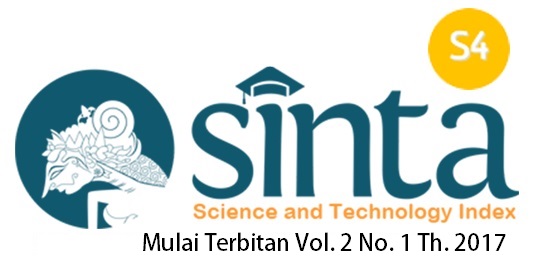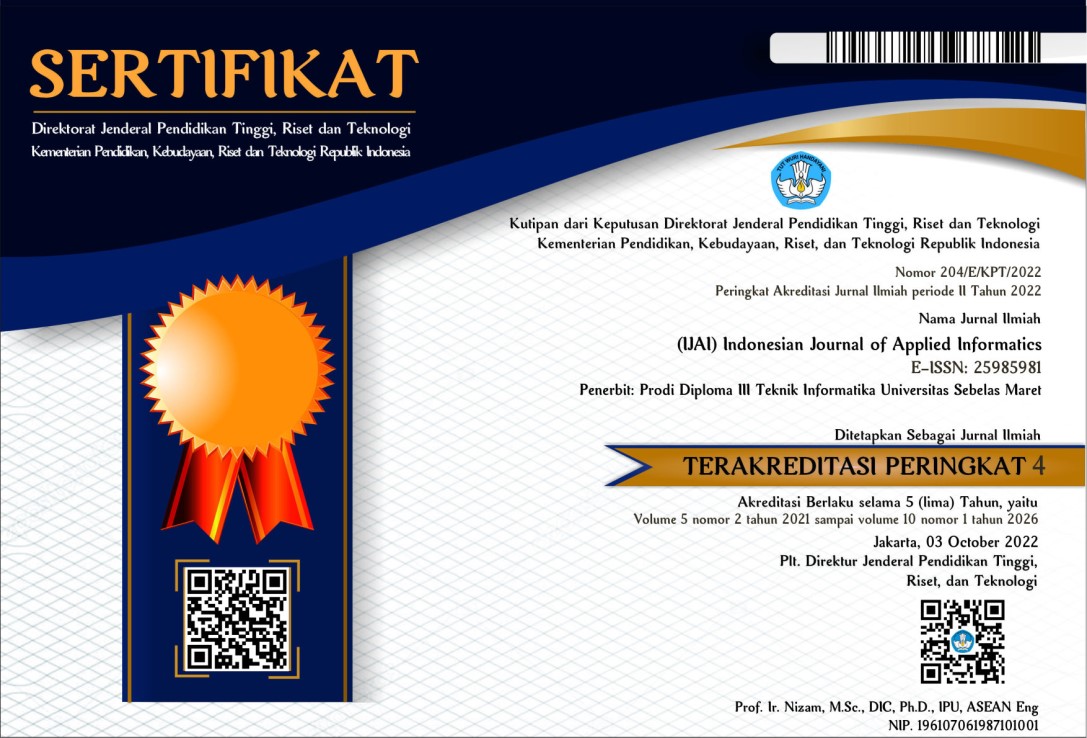Optimalisasi Klasterisasi Tenaga Kesehatan Menggunakan K-Means dan Davies Bouldin Indexs
Abstract
Abstrak :
Optimalisasi model pengelompokan data tenaga kesehatan adalah langkah strategis untuk memahami pola dan karakteristik kelompok data tertentu. Tujuan dari penelitian ini adalah untuk mendapatkan nilai K optimal menurut Davies Bouldin Indeks (DBI), mendapatkan nilai iterasi yang diperlukan oleh algoritma K-Means Clustering untuk mencapai hasil yang optimal, dan menentukan jenis metrik apa yang akan menghasilkan nilai (DBI) yang paling kecil. Hal ini penting karena penelitian ini membantu perencanaan distribusi tenaga kesehatan yang lebih efisien di wilayah Jawa Barat denfan menghasilkan klaster optimal berbasis K-Means dan Optimize Parameter Grid. Penggunaan metode Knowledge Discovery in Database (KDD), yang mencakup proses pemilihan, praproses, transformasi, data mining, dan interpretasi/ evaluasi hasil. Hasil penelitian ditunjukkan pada iterasi 1-10 menggunakan K=2 dengan nilai DBI terendah sebesar 0,377.
====================================================
Abstract :
Optimisation of health worker data clustering model is a strategic step to understand the patterns and characteristics of certain data groups. The objectives of this study are to obtain the optimal K value according to the Davies Bouldin Index (DBI), obtain the iteration value required by the K-Means Clustering algorithm to achieve optimal results, and determine what type of metric will produce the smallest (DBI) value. This is important because this research helps to plan a more efficient distribution of health workers in the West Java region by producing optimal clusters based on K-Means and Optimise Parameter Grid. The use of Knowledge Discovery in Database (KDD) method, which includes the process of selection, preprocessing, transformation, data mining, and interpretation/evaluation of results. The results showed in iterations 1-10 using K=2 with the lowest DBI value of 0.377.
Keywords
Full Text:
PDFReferences
[1] H. Zhong, G. Loukides, and R. Gwadera, “Clustering datasets with demographics and diagnosis codes,” J. Biomed. Inform., vol. 102, no. January, 2020, doi: 10.1016/j.jbi.2019.103360.
[2] V. Mhasawade, Y. Zhao, and R. Chunara, “Machine learning and algorithmic fairness in public and population health,” Nat. Mach. Intell., vol. 3, no. 8, pp. 659–666, 2021, doi: 10.1038/s42256-021-00373-4.
[3] R. Hammad, M. Barhoush, and B. H. Abed-Alguni, “A semantic-based approach for managing healthcare big data: A survey,” J. Healthc. Eng., vol. 2020, 2020, doi: 10.1155/2020/8865808.
[4] K. Wynter, S. Holton, J. Considine, and A. M. Hutchinson, “Since January 2020 Elsevier has created a COVID-19 resource centre with free information in English and Mandarin on the novel coronavirus COVID- 19 . The COVID-19 resource centre is hosted on Elsevier Connect , the company ’ s public news and information ,” no. January, 2020.
[5] C. Jongen, J. McCalman, S. Campbell, and R. Fagan, “Working well: Strategies to strengthen the workforce of the Indigenous primary healthcare sector,” BMC Health Serv. Res., vol. 19, no. 1, pp. 1–12, 2019, doi: 10.1186/s12913-019-4750-5.
[6] A. C. Cardoso-dos-Santos et al., “The importance of geographic and sociodemographic aspects in the characterization of mucopolysaccharidoses: a case series from Ceará state (Northeast Brazil),” J. Community Genet., pp. 573–580, 2024, doi: 10.1007/s12687-024-00718-7.
[7] J. Yue et al., “Evaluating the accessibility to healthcare facilities under the chinese hierarchical diagnosis and treatment system,” Geospat. Health, vol. 16, no. 2, 2021, doi: 10.4081/gh.2021.995.
[8] D. K. Sitinjak, B. A. Pangestu, and B. N. Sari, “Clustering Tenaga Kesehatan Berdasarkan Kecamatan di Kabupaten Karawang Menggunakan Algoritma K-Means,” J. Appl. Informatics Comput., vol. 6, no. 1, pp. 47–54, 2022, doi: 10.30871/jaic.v6i1.3855.
[9] H. Rosyid, R. Mailok, and M. M. Lakulu, “Optimizing k-means initial number of cluster based heuristic approach: Literature review analysis perspective,” Int. J. Artif. Intell., vol. 6, no. 2, pp. 120–124, 2019, doi: 10.36079/LAMINTANG.IJAI-0602.40.
[10] M. Rochmawati et al., “Implementasi Algoritma K-Means dalam Klasterisasi Penjualan pada Sebuah Perusahaan menggunakan Metodologi KDD Implementation of the K-Means Algorithm in Sales Clustering at a Company using the KDD Methodology,” vol. 13, pp. 54–62, 2024.
[11] F. Leoni, M. Carraro, E. McAuliffe, and S. Maffei, “Data-centric public services as potential source of policy knowledge. Can ‘design for policy’ help?,” Transform. Gov. People, Process Policy, vol. 17, no. 3, pp. 399–411, 2023, doi: 10.1108/TG-06-2022-0088.
[12] R. W. Sembiring Brahmana, F. A. Mohammed, and K. Chairuang, “Customer Segmentation Based on RFM Model Using K-Means, K-Medoids, and DBSCAN Methods,” Lontar Komput. J. Ilm. Teknol. Inf., vol. 11, no. 1, p. 32, 2020, doi: 10.24843/lkjiti.2020.v11.i01.p04.
[13] D. H. Khoiriyah and R. Ambarwati, “Dynamic Segmentation Analysis for Expedition Services: Integrating K-Means and Decision Tree,” J. Inf. Syst. Informatics, vol. 6, no. 1, pp. 363–377, 2024, doi: 10.51519/journalisi.v6i1.666.
[14] F. Del Giorgio Solfa and F. R. Simonato, “Big Data Analytics in Healthcare: Exploring the Role of Machine Learning in Predicting Patient Outcomes and Improving Healthcare Delivery,” Int. J. Comput. Inf. Manuf., vol. 3, no. 1, pp. 1–9, 2023, doi: 10.54489/ijcim.v3i1.235.
[15] M. Ezar, A. Rivan, R. A. Sonaru, and K. Kunci-Algoritma, “Perbandingan Metode K-Means Dan GA K-Means Untuk Clustering Dataset Heart Disease Patients hasil intra cluster dari GA K-Means lebih baik dibandingkan dengan K-Means dan untuk inter cluster sangat kecil perbedaannya, dimana rata-rata inter cluster metode ,” J. Tek. Inform. dan Sist. Inf., vol. 9, no. 3, p. 2585, 2022, [Online]. Available: http://jurnal.mdp.ac.id
[16] A. Idrus, N. Tarihoran, U. Supriatna, A. Tohir, S. Suwarni, and R. Rahim, “Distance Analysis Measuring for Clustering using K-Means and Davies Bouldin Index Algorithm,” TEM J., vol. 11, no. 4, pp. 1871–1876, 2022, doi: 10.18421/TEM114-55.
Refbacks
- There are currently no refbacks.






